The Latest Dirt - May 2024
-

2024 GTPS Succeeds Across the County
By Janet Miller, Mary Jo Corby and Wendy Kraft
The 2024 Great Tomato Plant Sale was the first year since COVID-19 that we have had a sale in all three county areas! Welcome back to Rivertown Garden, where there was a steady flow of customers all day – and the garden looked fabulous! At the Richmond Public Library, West County folks were lined up around the block for that sale.
What a difference a year makes. While 2023 was the most challenging year ever for GTPS plant propagation, 2024 was a pleasure! We were not without challenges - but freezing temperatures, lack of sunshine, etc., were not among them.
-

West County GTPS Serves Nearly 500 Residents
By Liz Rottger
Photos by Jim MarchettiPerhaps the most challenging of all of the Contra Costa UC Master Gardener's Great Tomato Plant Sales is in West County. Growing plants in one place and then selling them in an entirely different place is simply crazy. It takes a lot of work to transport over 6000 plants safely from the Water Conservation Garden in El Cerrito to the Civic Center Library in Richmond, even if it's only 3 miles. Along with these plants, we also transport additional plants (peppers, herbs, and eggplants) from Central County to Richmond and all the equipment (tables, cash registers, popups, etc.) we need for the sale.
-

West County GTPS Banner Honors Local Families
UC Master Gardeners Liz Rottger and Fletcher Oakes created this tribute poster for the West County Great Tomato Plant Sale to honor the sizeable flower-growing community of Japanese ancestry that settled in Richmond/El Cerrito and were incarcerated during World War II.
-

Pam Austin and the School Gardens
by David George
UC Master Gardener Pam Austin has been working and driving overtime as lead for the School Gardens project since the departure last year of Co-Lead Kate Verhoef from the Contra Costa program. Living in El Cerrito, Pam has held down the fort for all school garden opportunities, from Richmond in the west to San Ramon in the south and Oakley in the far east of the county. I spoke with Pam the other day about the challenges and opportunities in our School Gardens project and its future needs (Hint: Volunteers!)
-
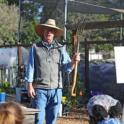
Why Do I Like Working on the Growing Gardener Project?
Article By Ann Ramirez
Photos by Hedwig Van Den Broeck-ClaeysSpring is here, and Summer is coming. We had our first group of enthusiastic beginning vegetable gardeners in February and are now beginning our May course.
Growing Gardeners has been called a light version of the New Volunteer Training program and has been a steppingstone to becoming a UC Master Gardener volunteer. The program provides student gardeners with the knowledge to identify their growing conditions to optimize their success.
-
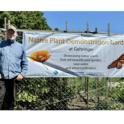
Growing Up Together
Article by Meb Phillips
Photos by Mary Beth Phillips
In some indigenous cultures, often in May, the golden triangle of the corn seed, the glossy brown bean, and the hand-pie-shaped squash seed are planted together in a mound. These are called the Three Sisters. The first to grow, the corn, like the firstborn in a family, shoots up straight, alone for a time. The bean takes its time as the second born because it first sends its long root deep into the earth. When the bean’s heart-shaped leaves break through, these heart leaves multiply and then become this flexible vine that searches, in a winding way, for something to hold onto before it catches the cornstalk, starts climbing, and flourishes.
-
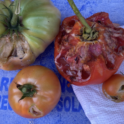
Can you tell me what's eating my beautiful tomatoes? Squirrels?
By Susan Heckly
Thank you for contacting the UC Master Gardener Program Help Desk and for sending a photo of your poor tomatoes.
If the tomatoes were still on your plants and not moved a distance away when you discovered this, it's rats doing the damage. Squirrels are more likely to remove the tomato and carry it to a nearby location to eat — often, you will find only a small part of a tomato. Rats will cling to the plant or the plant's support and eat the tomato in place, with much of the damage being on the top, like that on the red and green tomatoes in your photo. Rats are one of the most common pests we deal with in urban and suburban gardens. Birds can also do damage, but triangular bite marks would show on the fruit, and there isn't usually this much damage to an individual tomato.
-
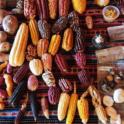
Growing Vegetables in Peru
Article & Photos By Anne Sutherland
My honey and I recently returned from the trip of a lifetime in Peru and the Galapagos. To our delight, biodiversity specialist Maywa Blanco talked about Peru’s many varieties of potatoes and corn when we were in Cusco. There is a seed library in Lima to ensure that these varieties are maintained. We saw many Peruvians selling beautiful fruits and vegetables on street corners throughout the country.
-
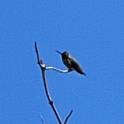
A Stubborn Watchman at the Low Water Garden
Article by Liz Rottger
Photos by Brian KerssThis past winter, Brian Kerss and Liv Imset decided to prune a large elderberry tree at the Low Water Garden in Richmond. The tree had struggled through the entire summer with a heavy infestation of aphids and the pursuant black sooty mold. The tree needed to be cut back to promote new growth. Before Brian and Liv even started, they spotted a hummingbird perched on one of its tallest, bare branches. As soon as they began to saw off a few of the limbs from the tree, the hummingbird would fly away, but when they stopped sawing, the hummingbird would immediately fly back to its perch. It was clear to both Liv and Brian that this branch was very important to the little hummer, and even though it looked a bit peculiar, they decided to leave this tall branch on the tree,









